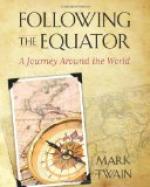’There were nae bairns
but only three
—Ane at the breast, twa at the
knee.’”
It ended the discussion. There was no man there profane enough, disloyal enough, to say any word against a thing which Robert Burns had settled. I shall always honor that great name for the salvation it brought me in this time of my sore need.
It is my belief that nearly any invented quotation, played with confidence, stands a good chance to deceive. There are people who think that honesty is always the best policy. This is a superstition; there are times when the appearance of it is worth six of it.
We are moving steadily southward-getting further and further down under the projecting paunch of the globe. Yesterday evening we saw the Big Dipper and the north star sink below the horizon and disappear from our world. No, not “we,” but they. They saw it—somebody saw it—and told me about it. But it is no matter, I was not caring for those things, I am tired of them, any way. I think they are well enough, but one doesn’t want them always hanging around. My interest was all in the Southern Cross. I had never seen that. I had heard about it all my life, and it was but natural that I should be burning to see it. No other constellation makes so much talk. I had nothing against the Big Dipper —and naturally couldn’t have anything against it, since it is a citizen of our own sky, and the property of the United States—but I did want it to move out of the way and give this foreigner a chance. Judging by the size of the talk which the Southern Cross had made, I supposed it would need a sky all to itself.
But that was a mistake. We saw the Cross to-night, and it is not large. Not large, and not strikingly bright. But it was low down toward the horizon, and it may improve when it gets up higher in the sky. It is ingeniously named, for it looks just as a cross would look if it looked like something else. But that description does not describe; it is too vague, too general, too indefinite. It does after a fashion suggest a cross across that is out of repair—or out of drawing; not correctly shaped. It is long, with a short cross-bar, and the cross-bar is canted out of the straight line.
It consists of four large stars and one little one. The little one is out of line and further damages the shape. It should have been placed at the intersection of the stem and the cross-bar. If you do not draw an imaginary line from star to star it does not suggest a cross—nor anything in particular.
One must ignore the little star, and leave it out of the combination—it confuses everything. If you leave it out, then you can make out of the four stars a sort of cross—out of true; or a sort of kite—out of true; or a sort of coffin-out of true.




